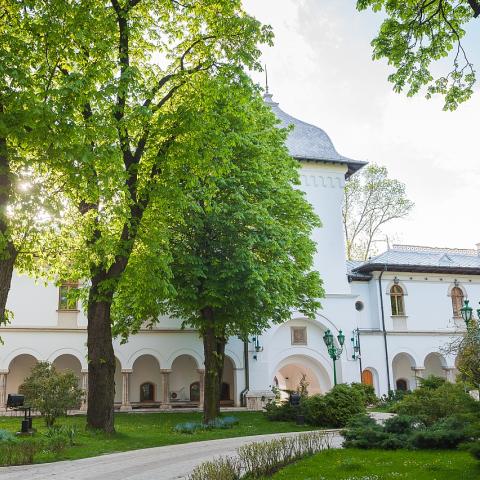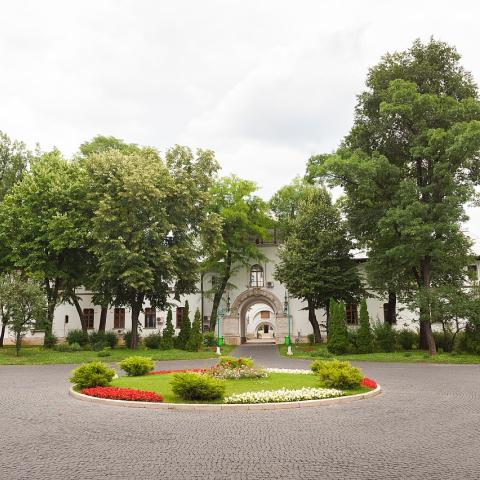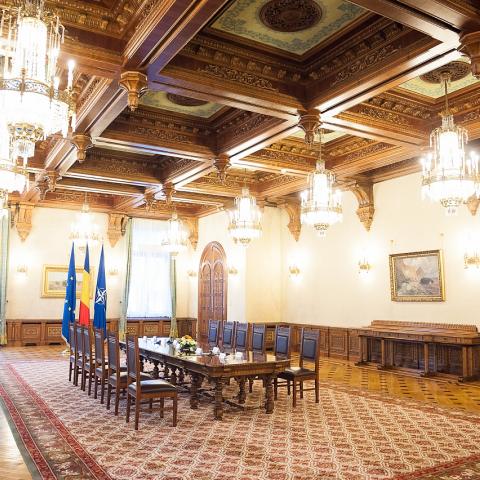Bucharest Centennial: Cotroceni Palace, where the kings signed the future of Great Romania

Romania-Insider.com has started a series of articles about Bucharest landmarks of architecture or history, which have witnessed the last century of what is now the Romanian capital, and noteworthy people who have helped build the Romanian capital as it is today. This project is supported by the Bucharest City Hall through the Public Monuments and Touristic Heritage Administration (AMPT), within the cultural program Bucharest-Centennial.
Check the full series of articles dedicated to the Centennial on Romania-Insider.com here.
Located in one of the oldest and most beautiful neighborhoods of the capital, the Cotroceni Palace is the guardian of several centuries of Romania’s history. Although its history starts earlier, the palace is often associated with the royal figures who established Great Romania. It served as their residence and several of the important events that preceded the Great Union of 1918 took place here.
The Cotroceni ensemble was the residence of several rulers of Ţara Românească (Wallachia) kingdom and it is one of its kind in the capital because of the many elements it encompasses. Besides the princely, and later, royal, palace, it hosted in time ecclesiastic constructions (the Cotroceni monastery, the chapel), railway ones (the Cotroceni station), and funeral monuments. It is the residence of the longest use on Romanian territories, since the end of the 17th century to the present.
The history of the ensemble dates all the way back to 1679, when Şerban Cantacuzino, a ruler of Wallachia, decided to build a monastery here. It was built on the Cotroceni hill after a part of the Vlăsiei woods were cleared. Besides a church similar to the Episcopal one in Curtea de Argeş, the ensemble included a Baroque-style princely palace and the princely houses.
The ensemble underwent alterations during the reign of Barbu Dimitrie Ştirbei, who redid and modernized the princely palace in 1852. He separated the domain of the monastery between the princely area and that of the future Botanical Garden of the capital.
After being elected the ruler of Ţara Românească, on January 24 1859 – the moment of the “Small” Union, and one of the stages preceding the Great Union of 1918 - Alexandru Ioan Cuza also lived at Cotroceni, where he had the summer residence. During Cuza’s rule, the ensemble underwent several transformations. In 1862, the old princely houses were decorated and refurnished with pieces belonging to the Second Empire style and with Western art objects.
After Cuza’s abdication, it was the turn of King Carol I to use the residence. During the time of the Independence War, following which Romania obtained its independence from the Ottoman Empire, Queen Elisabeth of Romania opened here a hospital for the wounded.
King Carol I requested the building of the Cotroceni Palace, which was to serve as residence for the family of the heir prince Ferdinand I. The palace was erected on the site of the old princely houses, and the government of the time allotted 1.7 million lei for the works. As such, the palace served as a residence of the royal family from 1893 to 1947.
The building was constructed after the plans of architect Paul Gotterau, who also worked on the projects of the C.E.C. Palace and of the Central University Library in Bucharest. Later, architect Grigore Cerchez added elements typical to the neo-Romanian style.
The palace was equipped with all of the facilities of the time, including electrical lighting and telephone, which had been introduced in the capital in 1890. Later, in 1915, the central heating was added. The steam-based installation at the moment of its construction was replaced with a radiator installation in 1916. New lighting equipment was added in 1927, and the elevator followed in 1936.
At the request of King Carol I, the Cotroceni Train Station was built close to the palace. It was the first royal train station and served its purpose until 1947. It was removed from use in the 1960s, together with the line section connecting it to the network of the Romanian Railways. The building of the former station is today one of the entrances to the palace, coming from the Geniului boulevard.
The future King Ferdinand I and his wife, the future Queen Marie, moved to the Cotroceni Palace in 1897, and the personalities of the two were later reflected in the way the space was furnished and decorated. Queen Marie, in particular, oversaw the improvements to the palace’s interior spaces, in various styles, which reflect, among others, the identity of the Romanian territories unified in 1918.
One of the important spaces of the palace is the Cerchez Room, named after architect Cerchez, who furbished it in a neo-Romanian style. This was done by transforming two other spaces, namely the Dance Hall and the Dining Room.
In the latter, King Ferdinand I signed in August 1916 Romania’s decision to enter the First World War on the side of the Entente (France, Russia and Great Britain) and against the Central Powers (Germany and Austria-Hungary). At the end of the conflict, Romania achieved the Great Union of 1918.
Architects Karel Limann and Ion Ernest worked alongside Cerchez and the architecture of the space includes references to the styles in Ţara Românească and Moldavia in the 17th century.
In 1918, Cotroceni was the place where Romania signed with the Central Powers the treaty known as the Peace of Bucharest. The treaty provided that Romania would give up Southern Dobrogea (The Cadrilater) and Northern Dobrogea to Bulgaria. On the other hand, Romania had the union with Bessarabia of March 1918 recognized. Although it was ratified by the Parliament, King Ferdinand I never signed the treaty. After Germany was defeated in the First World War, the document became obsolete, thus leaving open the opportunity of the Great Union, which materialized a few months later, in December 1918.
Cotroceni was also the place where the royal family returned in December 1918, after the two years spent in retreat in Iași during WWI, a moment described by Queen Marie in her memoirs.
After King Michael abdicated, beginning with 1949, Cotroceni hosted the Palace of the Pioneers. The construction was severely damaged by the 1977 earthquake and had to be rebuilt. Between 1980 and 1986 the new wing of Cotroceni was built, today the headquarters of the Presidential Administration.
The Silver Bedroom of Queen Marie, the cabinet of King Ferdinand I (The Library), King Carol’s German Living Room are just some of the spaces that can be visited at the Cotroceni Museum, an edifice which underwent multiple transformations, reflecting the historical events it hosted.
Visiting the museum:
The museum can be visited based on appointment, made at least 24 hours before.
Address: 1 Geniului Blvd. Closest metro stations: Eroilor, Grozăvești. Bus stations: Piața Leu, Grădina Botanică. Bus & trolley lines: 61, 62, 69, 90, 91, 93, 96, 136, 236, 336.
Photo source: Presidency.ro
Sources:
www.muzeulcotroceni.ro
Emanuela Florea-Paraipan. O vizită documentară la Muzeul Cotroceni (A Documentary Visit at the Cotroceni Museum). Studii de biblioteconomie și științele comunicării / Library and information Science Research, No. 20/2016
Bucureşti, al doilea oraş în care s-a sărbătorit Marea Unire. Întoarcerea Regelui Ferdinand şi a Reginei Maria în Capitală (Bucharest, the Second City that Celebrated the Great Union. The Return of King Ferdinand and of Queen Marie in the Capital) at Stiri.tvr.ro
1 decembrie 1918: „Visul de Aur al României”, spunea Regina Maria (December 1, 1918: The Golden Dream of Romania, Queen Marie used to say) at www.historia.ro
100 de ani de la semnarea Tratatului de la Buftea-Bucureşti (100 Years since the Signing of the Treaty of Buftea - Bucharest) at radioromaniacultural.ro
















